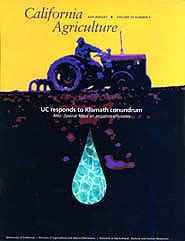All Issues

UC responds to Klamath conundrum
Also: Special focus on irrigation effiency
Cover:
From the Klamath Basin to the Rio Grande, water is a much-disputed commodity in California. Increasingly, agricultural users must compete with environmental and urban needs for scarce water supplies. In this issue of California Agriculture, news and research articles focus on how growers and other water users can irrigate more efficiently and effectively. The cover story explores how UC has responded to the water crisis in the Klamath Basin, where hundreds of growers did not receive irrigation water in 2001 due to a severe drought and concerns about protecting three endangered fish species. Through research and outreach, the University plays a critical role in ensuring that precious water is utilized to the best advantage for wildlife, crops, and people. Cover graphic by Davis Krauter
July-August 2002
Volume 56, Number 4
Volume 56, Number 4





